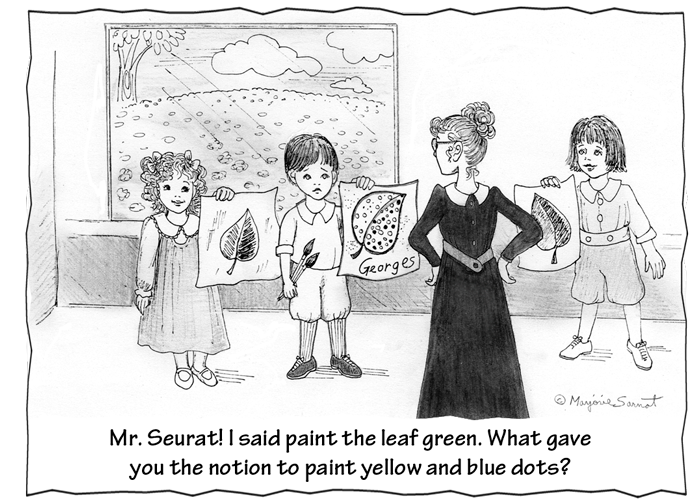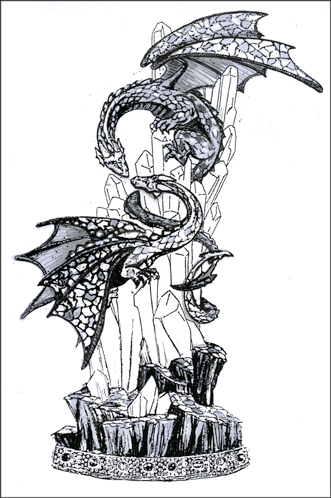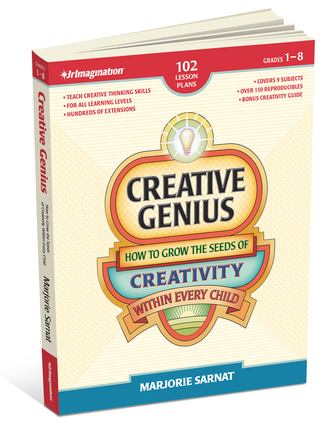Creative Connections
 Wednesday, September 21, 2011 at 8:50AM |
Wednesday, September 21, 2011 at 8:50AM |  Marjorie Sarnat
Marjorie Sarnat 
Creative thinkers play with metaphors and analogies. This means that they look at one thing as if it were another thing. They ask, “What else could this be like?” They make new connections between unrelated things.
 Dragons as spiraling tornadosArtists frequently use metaphors in their work. In the days when I was illustrating dragons for giftware manufacturers, I wanted my dragons to look dynamic. I asked myself, “What else looks dynamic?” A spiraling tornado. I used that concept to add lines of movement to my dragon poses; I thought of my dragons as spiraling tornados.
Dragons as spiraling tornadosArtists frequently use metaphors in their work. In the days when I was illustrating dragons for giftware manufacturers, I wanted my dragons to look dynamic. I asked myself, “What else looks dynamic?” A spiraling tornado. I used that concept to add lines of movement to my dragon poses; I thought of my dragons as spiraling tornados.
Musicians have been known to compose pieces based on the sounds of rainstorms, wind, or ocean tides. Berry Gordy, who founded the Motown sound in the 1960s, was inspired by the rhythmic sounds he heard in the auto factory where he worked. He connected those sounds to music and created something wonderful.
Many famous inventors have used analogies to solve problems. The Wright Brothers studied birds in flight and George de Mestral invented Velcro by observing burrs stuck on his socks. These inventors asked, “How can this phenomenon be translated to a man-made invention?” What could a burr from a plant near a river have in common with a ski jacket?
Connect the Dots of Paint
The French painter, Georges Seurat, made a creative connection in the late 1800s. As Seurat gazed at a green field dotted with yellow wildflowers, he observed that the field appeared to be solid yellow-green. That was the exact color that would result by mixing the dark green color of the leaves with the yellow color of the wildflowers.
Seurat speculated that if the eye can mix nature’s separate colors in a large field, why couldn’t the eye mix separate colors of paint on a canvas? Seurat experimented with dots of paint, and introduced Pointillism to the world. He had made a connection between a field of flowers and dots of paint on a canvas.
Connect Creative Thinking Skills to Fun
Encourage your kids to play with ideas, metaphors, and analogies. If this seems highly intellectual, it is not. While the concepts behind such play may be a subject of educational theorists, in the real world kids play this way all the time.
Every restless schoolchild who’s ever turned a wad of paper and a ruler into a ball and bat knows how to think metaphorically. Pretending things are other things is a classic favorite activity among kids of all ages. Recognize it as a valuable exercise in growing creative genius and offer ways to focus and stretch your kids’ natural creativity. Batter up!
Some “Not-Bored” Games
- Astro-tabletop Game – Try this imaginative game with your child next time he’s fidgety in a restaurant. Tell him that the tabletop is the surface of a strange planet. The napkin dispenser is a rocket ship and a dish is a volcano. Salt and pepper shakers are a lot like robots, and your hands are alien beasts who roam the planet. A simple game of “let’s pretend” actually exercises the creative muscles that make connections between unrelated things, such as seeing a hand as a beast.
- Tiger Toes Game – Here’s a lively game to play outside. Ask your child to pretend her feet are animals, such as two grasshoppers, two turtles, or two butterflies, and to let her animal feet move her around. Try several animals. Perhaps your child will grow up to invent a new kind of sport shoe!
- Alike Because… Game – With two or more people in the car, take turns as follows. Name one random thing that everyone can visualize, such as a scooter, a cat, or a Popsicle. Now ask a second player to name one more random thing. For example, you might say “flower.” The second player might say, “cell phone.” Take turns naming all the ways the two unrelated things are alike. For example “They are alike because: they both fit in a pocket… both have some green parts… both were created this year… both bring enjoyment… both are found on Earth… both break easily… both weigh less than one pound… both have a hollow part… both have a round part…” and so forth, until one of you runs out of “alikes.”
Connecting Ducks and Boots
This classroom lesson plan will stretch students’ creative thinking skills as they brainstorm to discover surprising commonalities between unrelated things. Our free download is here.
 Seurat,
Seurat,  analogies,
analogies,  children,
children,  connections,
connections,  creative playground,
creative playground,  creativity,
creativity,  games,
games,  kids,
kids,  metaphors,
metaphors,  students
students 


